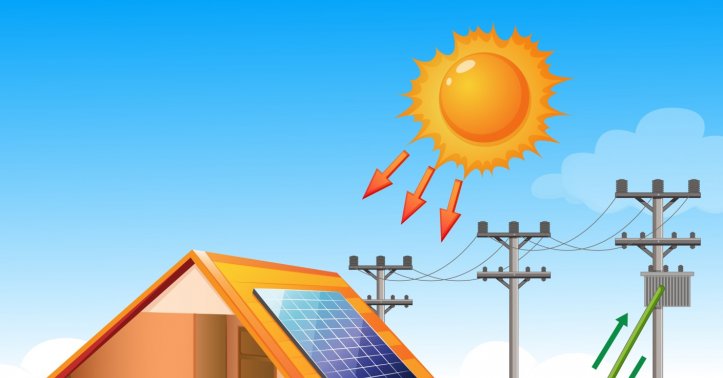
Using solar energy at home
Using solar energy at home has become increasingly accessible and affordable. Essentially, you're capturing the sun's energy and converting it into either electricity or thermal energy (heat) to power and run your home.
Here’s a comprehensive guide on how we use solar energy at home, from the most common systems to simpler, direct uses.
1. Solar Electricity (Photovoltaic - PV Systems)
This is the most popular and well-known method. You install solar panels on your roof or in your yard to generate electricity.
How it works:
Solar panels (made of photovoltaic cells) absorb sunlight. This sunlight knocks electrons loose, creating a flow of direct current (DC) electricity. An inverter then converts this DC electricity into the alternating current (AC) that your home appliances use.
Key Components:
-
Solar Panels: The visible arrays on the roof.
-
Inverter: Converts DC to AC power.
-
Racking/Mounting: Secures the panels to your roof or ground.
-
Performance Monitoring: Allows you to track your system's energy production (often via an app).
-
Battery Storage (Optional): Stores excess energy for use at night or during a power outage.
How you use the electricity:
The electricity generated by your solar panels is fed directly into your home's main electrical panel (breaker box). It powers everything just like grid electricity does:
-
Lights
-
Refrigerator
-
HVAC System (Heating and Air Conditioning)
-
TVs and Computers
-
Washing Machine and Dryer (if electric)
-
Electric Vehicle (EV) Charging
What happens with extra power?
Most homes are connected to the grid via net metering. When your system produces more electricity than you use, the excess is sent back to the utility grid, and your meter literally spins backwards. You get a credit from the utility company, which you can use to draw power from the grid at night or on cloudy days.
2. Solar Water Heating
This is one of the most efficient ways to use solar energy and is separate from a PV system. It uses the sun's thermal energy to heat your water.
How it works:
A "solar collector" is mounted on the roof, which absorbs heat from the sun. A fluid (either water or an antifreeze solution) circulates through this collector, gets hot, and then transfers that heat to your home's water tank.
Types of Systems:
-
Active Systems: Use pumps to circulate the fluid.
-
Passive Systems: Rely on natural convection (hot water rising) to move the fluid.
How you use it:
The pre-heated water from the solar system feeds into your conventional water heater (gas or electric). The conventional heater then has much less work to do, significantly reducing your energy bills for hot water, which is typically a home's second-largest energy expense.
3. Solar Pool Heating
A simple, cost-effective, and very popular use of solar energy, especially in sunny climates.
How it works:
A solar collector (often a series of dark plastic or rubber tubes mounted on a roof or rack) absorbs the sun's heat. Your pool's water is pumped through these collectors, warms up, and then is returned to the pool.
How you use it:
This system extends your swimming season by several months without the high cost of running a gas or electric pool heater.
4. Passive Solar Home Design
This isn't a technology you install, but a way of designing and building a home to naturally capture, store, and distribute solar energy as heat in the winter and reject it in the summer.
Key Principles:
-
South-Facing Windows (in the Northern Hemisphere): Large windows on the south side of the home let in low-angle winter sun to warm the interior.
-
Thermal Mass: Materials like concrete, brick, or tile inside the home absorb the solar heat during the day and release it slowly at night.
-
Proper Insulation and Sealing: Keeps the heat inside when it's cold.
-
Shading: Overhangs or deciduous trees are designed to block the high-angle summer sun to keep the house cool.
How you use it:
You live in a home that is naturally warmer in the winter and cooler in the summer, drastically reducing your need for mechanical heating and cooling.
5. Small-Scale and DIY Solar
You don't need a whole-house system to start using solar energy.
-
Solar-Powered Outdoor Lights: Pathway lights, security lights, and string lights have their own small panels and batteries.
-
Solar Phone Chargers & Power Banks: Portable panels you can use in your backyard or while camping.
-
Solar-Powered Ventilation Fans: Attic or greenhouse fans that run on solar power to reduce heat buildup.
-
Solar Water Features: Small fountains for your garden that run on a tiny solar panel.
Getting Started: A Quick Checklist
-
Analyze Your Energy Use: Look at your electricity bills to see how much energy you consume. The U.S. Energy Information Administration has a useful tool to compare your usage to similar homes: https://www.eia.gov/consumption/residential/
-
Assess Your Solar Potential:
-
Sunlight: Does your roof get good, unshaded sunlight for most of the day (especially between 9 AM and 3 PM)?
-
Roof Condition: Is your roof in good shape and facing a favorable direction (South in the Northern Hemisphere)?
-
Explore Financing: Options include purchasing with cash or a loan, or leasing a system.
-
Get Multiple Quotes: Contact 2-3 reputable local solar installers for assessments and quotes.
-
Check for Incentives: Look for federal, state, and local incentives like tax credits and rebates.
By adopting solar energy, you not only save money on your utility bills but also increase your energy independence and reduce your carbon footprint.
By Jamuna Rangachari








